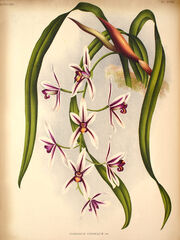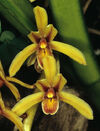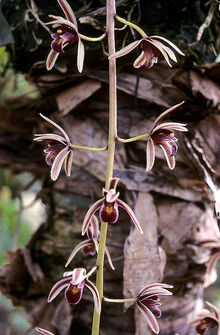| Cymbidium aloifolium | |||||||||||||||||
|---|---|---|---|---|---|---|---|---|---|---|---|---|---|---|---|---|---|
| |||||||||||||||||
Cymbidium aloifolium is a species of Cymbidium which blooms on a pendant inflorescence.
Description[]
Plant blooms on a 75 cm pendant inflorescence with up to 75 flowers. Flowers are 4.25 cm wide with red stripes on petals and sepal. The plant produces four to five leaves per growth.
The species' flowers can be easily confused with Cymbidium dayanum but differs by having a rounded lip edge and an hourglass shape in the center of the lip. Plant blooms in winter to early spring. This species is similar to Cymbidium bicolor, but differs by the strong veined maroon color on the side of the lip and the length of the sidelobes are also longer.[1]
Cymbidium aloifolium was the first species of Cymbidium known in Europe which was described by Linnaeus as Epidendrum aloifolium in Species Plantarum in 1753 based on illustrations by Rheede.[1] The drawings were based on a plant collected in southwestern peninsular India growing on a tree of Strychnos nux-vomica.[1]
The plant was transferred to the genus Cymbidium by Swartz in 1799.[1] Because the species was confused with Cymbidium bicolor, Rolfe did a study of the Cymbidium aloifolium and bicolor complex in 1917 and recognized five separate species.[1] Both Cymbidium bicolor and Cymbidium aloifolium grow in similar habitats and colonize in similar niches.[1] They often form extensive root systems on rotting wood. Although their distribution range overlaps, the two species do not seem to hybridize due to the slight difference in flowering seasons.[1]
Distribution[]
Cymbidium aloifolium is found in dry decidious forests in tree trunk and branches, mossy rocks, rotting wood, and leaf litter of open areas with partial shade. The plant is found at elevations of 0 to 1500 meters in Guangdong, Hong Kong, China; Bangladesh; eastern Himalayas; Assam. India and Andaman Islands; Nepal; Sri Lanka; Myanamar; Thailand; Laos; Cambodia; Vietnam; Malaysia; Java and Sumatra.
The plant is also found growing on trunks of palm trees and on rocks.[1]
Culture[]

Plate of Cymbidium aloifolium
Plant should be grown in intermediate to warm areas with medium to bright light. Pot with bark and perlite. Plant prefers dry periods between watering. Reduce watering during the winter.
Varieties[]
| Image | Name | Description |
|---|---|---|

|
Cymbidium aloifolium | Sepals are yellow and petals are yellow with a red stripe, lip is yellow with red stripes |
Naming[]
Common Name: The Aloe-Leafed Cymbidium
Synonyms[]
- Aerides borassi Buch.-Ham. ex Sm. 1813
- Cymbidium crassifolium Wall. 1828
- Cymbidium erectum Wight 1852
- Cymbidium intermedium H.G.Jones 1974
- Cymbidium mannii Rchb. f. 1872
- Cymbidium pendulum (Roxb.) Sw. 1799
- Cymbidium simulans Rolfe 1917
- Epidendrum aloides Curtis 1797
- Epidendrum aloifolium L. 1753
- Epidendrum pendulum Roxb. 1795
Resources[]
![]() Cost effective protocol for in vitro mass propagation of Cymbidium aloifolium
Cost effective protocol for in vitro mass propagation of Cymbidium aloifolium
